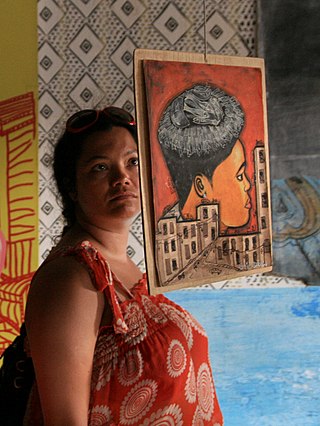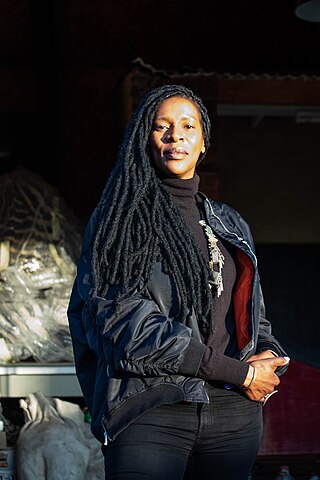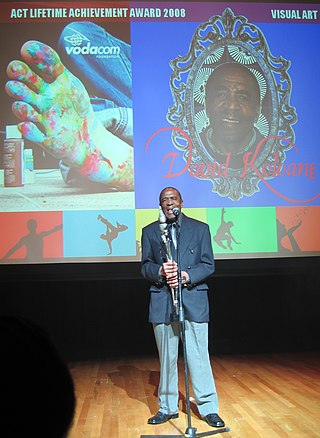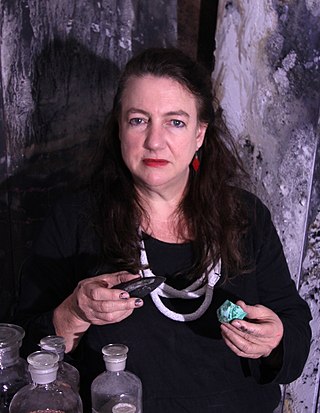
The Iziko South African National Gallery is the national art gallery of South Africa located in Cape Town. It became part of the Iziko collection of museums – as managed by the Department of Arts and Culture – in 2001. It then became an agency of the Department of Arts and Culture. Its collection consists largely of Dutch, French and British works from the 17th to the 19th century. This includes lithographs, etchings and some early 20th-century British paintings. Contemporary art work displayed in the gallery is selected from many of South Africa's communities and the gallery houses an authoritative collection of sculpture and beadwork.
Berni Searle is an artist who works with photography, video, and film to produce lens-based installations that stage narratives connected to history, identity, memory, and place. Often politically and socially engaged, her work also draws on universal emotions associated with vulnerability, loss and beauty.

Judith Mason born Judith Seelander Menge was a South African artist who worked in oil, pencil, printmaking and mixed media. Her work is rich in symbolism and mythology, displaying a rare technical virtuosity.
Minnette Vári is a South African artist known primarily for her video installations. Born in Pretoria, Vári studied fine arts at the University of Pretoria where she obtained her master's degree. She lives and works in Johannesburg.

Tracey Rose is a South African artist who lives and works in Johannesburg. Rose is best known for her performances, video installations, and photographs.

Diane Victor, is a South African artist and print maker, known for her satirical and social commentary of contemporary South African politics.

Nandipha Mntambo is a South African artist who has become famous for her sculptures, videos and photographs that focus on human female body and identity by using natural, organic materials. Her art style has been self described as eclectic and androgynous. She is best known for her cowhide sculptures that connects the human form to nature.

David Nthubu Koloane was a South African artist. In his drawings, paintings and collages he explored questions about political injustice and human rights. Koloane is considered to have been "an influential artist and writer of the apartheid years" in South Africa.
Tom Cullberg is an artist born in Stockholm, Sweden, in 1972. He currently lives and works in Cape Town, South Africa.

Christo Coetzee was a South African assemblage and Neo-Baroque artist closely associated with the avant-garde art movements of Europe and Japan during the 1950s and 1960s. Under the influence of art theorist Michel Tapié, art dealer Rodolphe Stadler and art collector and photographer Anthony Denney, as well as the Gutai group of Japan, he developed his oeuvre alongside those of artists strongly influenced by Tapié's Un Art Autre (1952), such as Georges Mathieu, Alfred Wols, Jean Dubuffet, Jean Fautrier, Hans Hartung, Pierre Soulages, Antoni Tàpies and Lucio Fontana.

Kathryn Smith is a South African artist, curator, and researcher. She works on curatorial projects, scholarly research, and studio practices, while her art deals with uncertainty, risk, and experimentation. She works in Cape Town and Stellenbosch. Her works have been exhibited and collected in South Africa and elsewhere. In 2006, she was appointed senior lecturer in the Department of Visual Arts at the University of Stellenbosch and head of the Fine Arts Studio Practice program. She took a break in 2012/2013 to read for an MSc at the University of Dundee.
James Webb is a South African artist best known for his interventions and installations incorporating sound. Webb also works as a sound designer, curator and teacher. His sound installations place special emphasis on the sourcing and presentation of the sound clips, as well as the social significance and context of these sounds. Often referred to as a "collector of sounds," Webb is interested in the role that aural events play in our everyday life. The physical presentation of the work, including the installation space and the logistics of speakers, are also deliberate choices for Webb.
Wim Botha is a South African contemporary artist.
Deborah Bell is a South African painter and sculptor whose works are known internationally.
iQhiya is a network of young black women artists based in Cape Town and Johannesburg, South Africa. They specialise in a broad range of artistic disciplines including performance art, video, photography, sculpture and other mediums.

Jeannette Unite is a South African artist who has collected oxides, metal salts and residues from mines, heritage and industrial sites to develop paint, pastel and glass recipes for her large scale artworks that reflect on the mining and industrial sites where humanity's contemporary world is manufactured.
Kagiso Patrick "Pat" Mautloa is a multi-media visual artist based in Johannesburg, South Africa.

Senzeni Marasela is a South African visual artist born in Thokoza who works across different media, combining performance, photography, video, prints, textiles, and embroidery in mixed-medium installations. She obtained a BA in Fine Arts at the Wits School of Arts, University of the Witwatersrand, Johannesburg in 1998. Her work is exhibited in South Africa, Europe, and the United States, and is part of local and international collections, including Museum of Modern Art or the Newark Museum and is referenced in numerous academic papers, theses journal, and book publications.
Mmakgabo Mmapula Mmangankato Helen Sebidi is a South African artist born in Marapyane (Skilpadfontein) near Hamanskraal, Pretoria who lives and works in Johannesburg. Sebidi's work has been represented in private and public collections, including at the National Museum of Women in the Arts, Washington and New York the Smithsonian National Museum of African Art, New York, and the World Bank. Her work has been recognised internationally and locally. In 1989 she won the Standard Bank Young Artist award, becoming the first black woman to win the award. In 2004, President Thabo Mbeki awarded her the Order of Ikhamanga in Silver – which is the highest honor given to those considered a "national treasure". In 2011, she was awarded the Arts and Culture Trust (ACT) Lifetime Achievement Award for Visual Art, whilst in 2015 she received the Mbokodo Award. In September 2018, Sebidi was honoured with one of the first solo presentations at the Norval Foundation in Cape Town – a retrospective entitled Batlhaping Ba Re.
Gerald Machona is a Zimbabwean contemporary visual artist. The most recognizable aspect of his work is his use of decommissioned Zimbabwean dollars. Machona works in sculpture, performance, new media, photography and film. In Machona's work, he explores issues of migration, transnationality, social interaction and xenophobia in South Africa.













